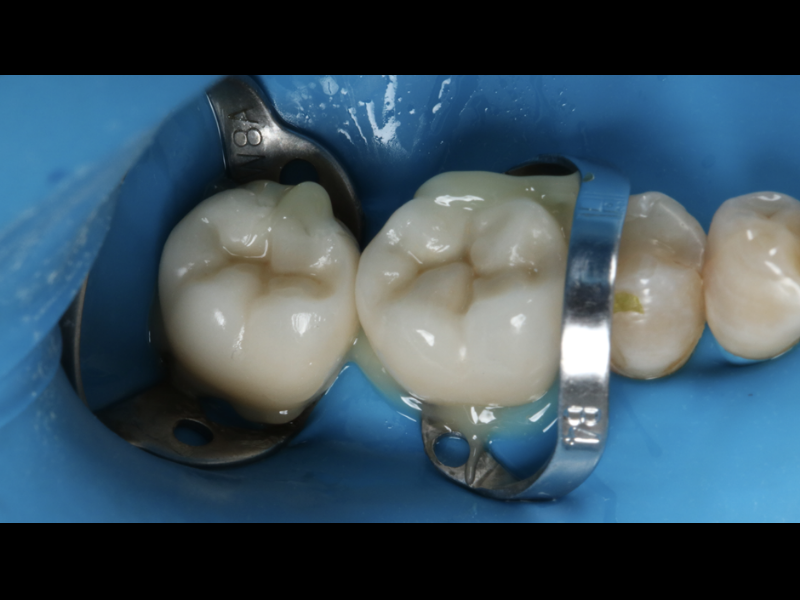Dr. Pedro Alexandre
Large resin or amalgam restorations are commonly encountered in everyday clinical practice. In the case of amalgam restorations, they were the best direct restorative alternative for cases of extensive coronal destruction for a long period. However, despite their advantages, due to their high coefficient of thermal expansion and high modulus of elasticity – which can lead to cracks and structural fractures of the tooth – and their lack of aesthetics, which can be a criterion for replacement, it is now uninteresting to maintain large amalgam restorations because there are better materials available. Careful replacement of these restorations can prevent or at least delay structural fractures of the tooth that might lead to the need for an implant, for example.
Composite resins are a material option for replacement of restorations, but the classic literature indication for direct posterior resin restorations does not support their direct use for cusp replacement. It supports their use for isthmuses smaller than 1/3 of the intercuspal distance, although today, this form of usage is widely promoted and demonstrated. As seen in Photo 1, where tooth 46 was directly restored, it had significant areas of leakage, as well as loss of morphology and wear that culminated in the eruption of the opposing tooth, creating occlusal unevenness issues.
This case report aims to showcase an already widely known alternative: indirect ceramic restorations known as “onlays and overlays,” produced with glass ceramics.
The patient presented to the office with large amalgam restorations in the posterior teeth in both arches, with several of them having fractured cusps and some teeth showing significant cracks and sensitivity. The treatment goal was to provide greater masticatory comfort and preserve the structures, avoiding dental fractures.

Initial state of teeth 46 and 47 – Tooth 46 with endodontic treatment and a large composite resin restoration, and tooth 47 with a large amalgam restoration. In both cases, the risk of catastrophic dental structure fracture is imminent, and cuspal protection plays an interesting role in the longevity of these teeth.

Considering the extensive amalgam restoration, we chose to remove the restorative material under rubber dam isolation. This was done to prevent the patient from swallowing amalgam and to ensure a smoother procedure, as the tongue and cheeks would not interfere with the process.

Prior to the preparation of the overlays, a molding was taken using dense and fluid condensation silicone to replicate the patient’s teeth. This would allow for the quick fabrication of temporary restorations using PrimmaArt Bisacrylic Resin (FGM).

For the preparation of the teeth, considering aesthetic considerations as well, the decision was made to perform an overlay preparation. A chamfer was applied on the buccal surface to enable the masking of the darkened background. Note that the lingual surface still had a good amount of enamel remaining, which was preserved to avoid further unnecessary loss of healthy structure and to take advantage of the excellent bonding to the remaining enamel. The shade guide serves as a reference for the laboratory to understand the color of the substrate and the target color for the new restorations.

With the moldings and records completed, the provisionals could be fabricated using PrimmaArt Bisacrylic Resin in 5 minutes. Note that even without polishing, the material exhibits excellent shine and a smooth surface, in addition to being highly durable.

In seven days, we obtained these beautifully crafted ceramic pieces, very well executed.

An important step in the surface treatment of ceramic pieces, the etching with Hydrofluoric Acid in this case should be carried out for 20 seconds. These are glass-ceramics reinforced with lithium disilicate, and Condac Porcelana 10% was chosen due to its excellent thixotropy and the thickness of the piece.

Opaque white appearance of the pieces immediately after etching with hydrofluoric acid.

Application of Silane (Prosil FGM) – cross-linking agent – is what will allow the bonding between the ceramic and the resin material responsible for the adhesive cementation of the overlays.

To ensure the best possible adhesion, absolute isolation is essential. In these cases, the dependence on adhesive bonding is maximum, so tooth cleaning and maintaining a clean and dry environment are essential for long-term success.

The dental surface treatment for adhesion in this case included not only sandblasting the surface with aluminum oxide but also conditioning with phosphoric acid Condac 37 (FGM). And the adhesive system used was the Ambar Universal APS system (FGM).

The cement of choice for these cases is Allcem Core due to its dual curing nature and excellent properties such as viscosity and mechanical strength.

The resin cement is applied using its mixing tips, both on the restoration and the tooth, allowing for a slight excess and overflow of the cement. At this point, with gentle digital pressure or using a suitable instrument, the restoration is placed into position. Excess cement is then removed using a brush before the cement chemically polymerizes.

Immediate Finalization























